Guide to Identifying Soybean Nutrient Deficiencies, Soybean Diseases and Corn Diseases
BY Dairyland Seed Agronomy Team
COMMON SOYBEAN NUTRIENT DEFICIENCIES
Many areas across the Dairyland Seed footprint have experienced severe moisture variation -- either too much or not enough. During prolonged stress periods, soybeans can show symptoms of nutrient deficiency. In many cases, there may be adequate nutrient levels in the soil, but droughty or waterlogged conditions may render the nutrient unavailable to the plant. The following are examples of common nutrient deficiency in soybeans.
Potassium
Symptoms of potassium deficiency are yellowing of the leaf margins that progress toward the center of the leaf. Leaf margins may turn brown and necrotic. Usually, older leaves or leaves toward the bottom of the plant, will exhibit symptoms first, but whole plants can show symptoms during periods of rapid growth. Potassium deficiency can be found where compaction, ponding, or root damage are prevalent.
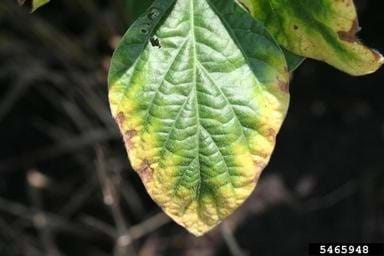
Daren Mueller, Iowa State University, Bugwood.org
Manganese
Symptoms of Manganese deficiency also referred to as “yellow flash” are interveinal chlorosis, or the yellowing of leaf tissue between the veins while the veins remain darker green. In severe cases, small necrotic or brown spots may appear on the tissue between the veins. The leaves impacted are at the top of the canopy or younger leaves. Causes for Mn deficiency are high soil pH, droughty soil conditions and applications of certain herbicides like glyphosate. Sandy soils or soils that are high in organic matter are most prone to Mn deficiency.

Vyn, Tony Purdue University
Iron
Iron Deficiency Chlorosis or IDC is commonly confused with Mn deficiency because symptomology is similar. IDC impacts younger leaves; the interveinal chlorosis and small necrotic spots are similar to symptoms of Mn deficiency. IDC appears in calcareous soils with high pH. Early season expression of these symptoms often points to IDC where later vegetative stages into reproductive stages point to Mn deficiency. Lab analysis can be implemented to determine an accurate diagnosis.
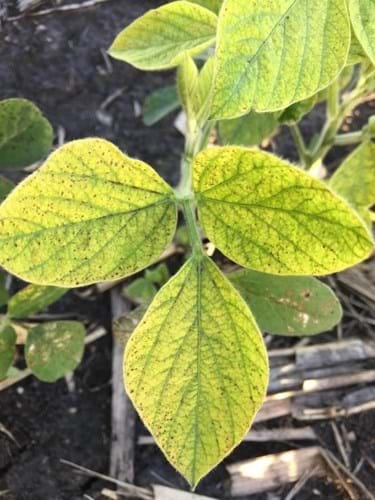
Crop Protection Network
This list is not a comprehensive list of nutrient deficiencies in soybeans, but are deficiencies commonly seen in the Dairyland Seed footprint during this time of year. It can be helpful in taking note where these symptoms appear in a field so that steps can be taken to prevent possible yield impact in the future. If you have any questions regarding possible nutrient deficiencies in crops contact your Dairyland Seed DSM or Regional Agronomist for more information.
IDENTIFYING SOYBEAN DISEASES AND SOYBEAN CYST NEMATODE
White Mold
White Mold, Sclerotinia sclerotiorum, primarily infects the soybean plant through the flowers. Humid conditions coupled with rain and moderate temperatures during soybean flowering are conducive for white mold infection. This fungus can survive in the soil as sclerotia for several years so management is important. Fungicides are effective against white mold if applied around the R1-R3 growth stage. Other management practices include lower planting populations, wide row spacing, crop rotation and tillage.
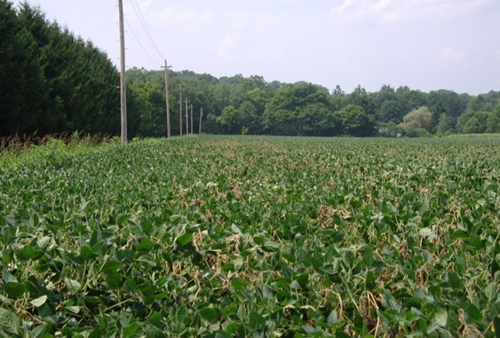
Foliar symptoms are interveinal coloring of grey-green and can resemble other soybean diseases such as brown stem rot or stem canker. Symptoms usually appear in soybeans between the R3 and R6 growth stage. Fluffy white mycelium growth can be found on the stems near the nodes. Leaves of infected plants eventually die but remain attached to the stem.
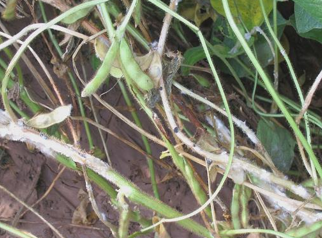
Sudden Death Syndrome
Sudden Death Syndrome (SDS) is caused by the fungus Fusarium virguliforme and infection occurs in early spring. Disease symptoms don’t usually appear until around August. This is because rain during the reproductive stage can cause the disease to start producing toxins which can kill the leaves. SDS tends to favor early planted soybeans, cool damp soils and compacted soils. The other factor common with SDS is Soybean Cyst Nematode (SCN). The SDS organism overwinters in the soil, in crop residue and in the soybean cyst which is why there is a close association between SCN and SDS. Losses from SDS range from minimal to, in some cases, severe.
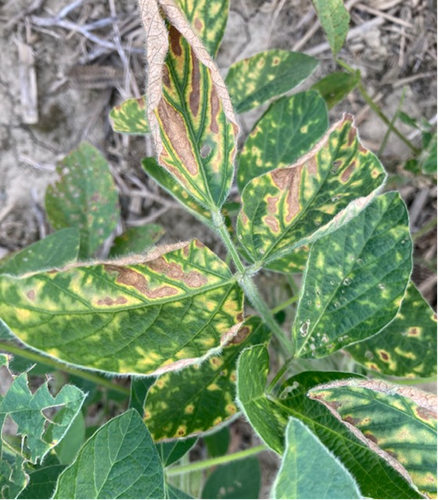
The first noticeable SDS symptoms are chlorotic blotches that form between the veins of the soybean leaflets, which expands and turns necrotic. Those leaves will die and can drop off, leaving only the leaf petiole. The final diagnosis includes splitting the stem to look for discolored stem cortex. The cortex will have a light brown discoloration while the pith will remain white. Brown stem rot (BSR) can have similar leaf symptomology but will have a brown discolored pith when the stem is split.
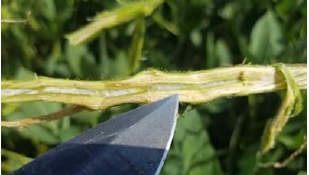
Controlling SDS after infection is not possible so prevention is key. Keep accurate records of problem fields and varieties. Planting problem fields later in the spring and eliminating soil compaction can also help in reducing the incidence of SDS. Selecting soybean varieties tolerant to SDS and containing SCN, along with using seed treatments like ILeVO® will help control SDS and SCN.
Brown Stem Rot
Similar to SDS, the soilborne fungi that causes Brown Stem Rot (BSR) infects early in the spring and symptoms don’t usually show up until the soybean is in reproductive stages. BSR is caused by the fungus Phialophora gregata which infects the plant through the roots and then grows inside the vascular tissue. There are two different genotypes of the fungus that causes BSR. Type A causes leaf and stem symptoms and is more aggressive. Type B typically only causes stem symptoms and is less aggressive.
Symptoms usually appear around the R3-R4 growth stages and are favored by cooler temperatures and adequate moisture. Foliar symptoms can appear similar to SDS with interveinal chlorosis that turns necrotic. BSR will have a brown discolored pith that extends from the lower stem upward, while SDS will have a white pith.
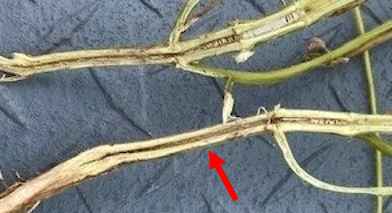
BSR cannot be controlled once the plants have been infected. Soybean cyst nematode is also known to contribute to BSR infection so selecting a variety that has SCN resistance along with BSR tolerance will be key in helping to prevent BSR in future years. Other management practices include rotating away from susceptible crops for two or more years and using tillage to incorporate plant residue.
Frogeye Leaf Spot
Frogeye leaf spot is caused by the fungus Cercospora sojina, and typically infects after flowering. Warm, humid conditions and/or frequent rains favor the development of this disease. Frogeye leaf spot lesions are more commonly seen on soybean leaves, with the younger leaves being more susceptible. In severe cases, lesions can develop on stems and pods.
Lesions of frogeye leaf spot are small, circular gray spots with reddish-brown margins. As these lesions age, the center becomes light brown to gray with a dark border. The lesions can coalesce to create larger, irregular areas. Frogeye leaf spot lesions on leaves are commonly mistaken for herbicide damage. The best time to scout for frogeye leaf spot is from R3 (beginning pod) through R6 (full seed).
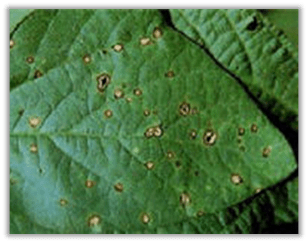
When scouting for frogeye leaf spot, focus on fields that are continuous soybeans and collects moisture for extended periods of time. The best way to manage frogeye leaf spot is to bury infected residue and rotate to a non-bean crop. When planting soybeans back in the infected field be sure to use a variety with high tolerance to frogeye leaf spot. The use of seed treatments and foliar fungicides may also provide some control.
Soybean Cyst Nematode
Soybean cyst nematode (SCN) is a microscopic roundworm that feeds on soybean roots. SCN may suppress nodulation, cause significant root damage, plant stunting and yellowing. The feeding from SCN can cause an entry point for diseases like SDS (sudden death syndrome) to attack the plant. Above-ground symptoms of SCN include oval shaped patterns of stunted, yellow plants with low vigor. Below-ground symptoms are stunted roots that may be discolored, have fewer nodules, and have SCN females present. SCN females are tiny structures attached to the roots, much smaller than nodules and initially white in color. Over time they turn from white to yellow and finally to brown once they are mature.
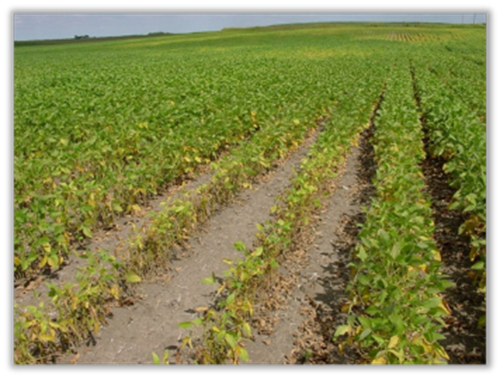
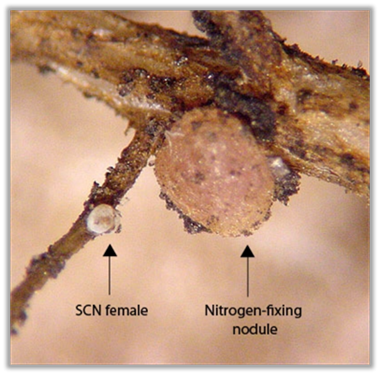
When scouting for SCN, focus on consistently low-yielding areas of the field. Dig up plants in those areas and carefully crumble the soil off of the roots but not hard enough to knock off the cysts. Closely examine the roots, especially the fine roots for SCN females. The best time for scouting is about six weeks after planting through about three weeks before harvest. If you suspect SCN then collect about 15-25 soil cores from about 6-8 inches deep and send to a diagnostic lab. Cysts can remain viable in the soil for more than 10 years so management is very important. Management strategies for SCN include rotating to a non-host crop, planting soybeans with SCN resistance, rotating between PI88788 and Peking resistance sources, and incorporating ILeVO in your seed treatment.
5 KEY CORN FOLIAR DISEASES IN THE UPPER MIDWEST
Anthracnose Leaf Blight
Oval-shaped lesions that start as water-soaked impressions and progress to tan centers with reddish-brown margins. Symptoms will begin in the lower canopy and move up the plant. Lesions can grow to several inches in length and join to completely kill a leaf. Though caused by the same pathogen, anthracnose stalk rot infection is independent of the leaf blight. The two versions may or may not occur simultaneously.
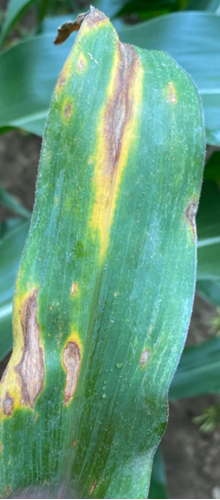
Gray Leaf Spot
Lesions of this disease are named after gray spores that are released as the fungus matures. Perhaps a more defining feature is the shape. The fungus is contained by the leaf veins of the plant, so it maintains a straight edge appearance with squared ends. Legions can be ½”-4” long.
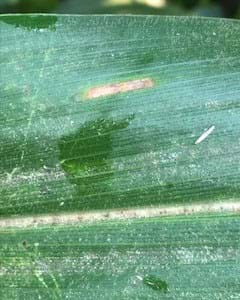
Tar Spot
Tar Spot is creating a lot of buzz these days, and for good reason. It can progress quickly and it has a polycyclic lifecycle, which means that it can reproduce over and over in one season if conditions are right. Identification is relatively easy after you see is once. The black spots will appear as splattered paint. The “tar” reference is likely from the fact that the spots cannot be wiped off the leaf, which is the main differentiator from basic insect frass. As the disease progresses, halos of necrotic plant tissue will form around the black spots.
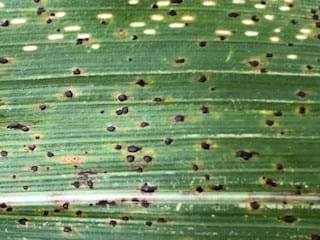
Goss’s Wilt
Goss’s wilt is the only bacterial disease on this list, and therefore cannot be controlled with a fungicide. Mature plants that are infected will have wavy leaf margins and dark green to black freckles which are better observed against sunlight.
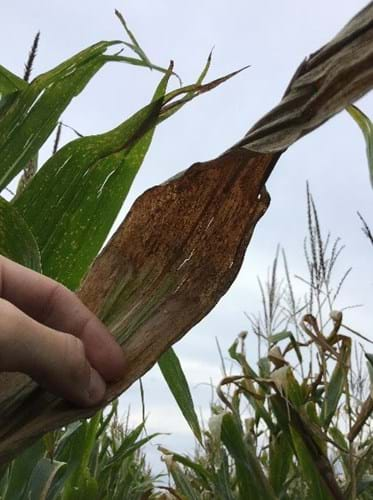
Northern Corn Leaf Blight
NCLB symptoms are long cigar-shaped lesions that range from 1-6” long. Typical progression through the plant is from bottom to top. As with other-diseases, lesions can progress to killing leaf material. This disease can look very similar to anthracnose leaf blight, but will not be as irregular in shape.
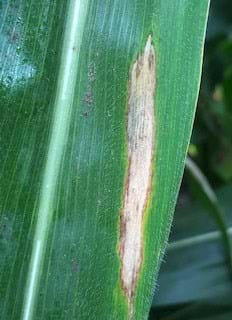
 |
 |
 |
 |
 |
| Brian Weller Western Region 507.456.3034 |
Dan Ritter Central Region 219.863.0583 |
Branden Furseth Northern Region 608.513.4265 |
Mark Gibson Eastern Region 260.330.8968 |
Amanda Goffnett Eastern Region 989.400.3793 |
